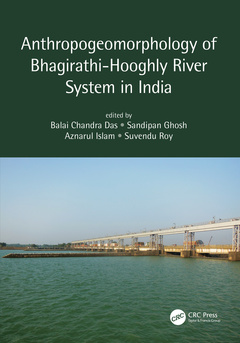Anthropogeomorphology of Bhagirathi-Hooghly River System in India
Coordonnateurs : Das Balai Chandra, Ghosh Sandipan, Islam Aznarul, Roy Suvendu

The Bhagirathi-Hooghly Basin in India is one of the most densely populated regions in the world and is undergoing rapid transformation of its natural landscape induced by human interventions, such as mushrooming of dams and barrages, deforestation, and urbanization. Human activities and interventions on basin landforms and the processes that shape those landforms have accelerated at an alarming rate. This book uses spatio-temporal analysis to understand the major anthropogenic signatures on land use and land cover changes and the impact these activities have on the landforms and processes of the Bhagirathi-Hooghly River and its sub-basins. It answers the what, where, why, and how of the anthropogenic signatures involved. Recent case studies on the impact of anthropogenic signatures on fluvial forms and processes make this book a useful resource for students and researchers in the earth sciences, local governments, urban planners, and all concerned with rural developments.
Features:
- Explores for the first time the new concept of anthropogeomorphology for the river basin?an emerging field
- Analyses the impact of anthropogenic activities, especially the construction of dams and reservoirs, and urbanization on major fluvial landscapes using advanced geospatial modelling techniques
- Investigates human interference in river systems, their effects on the dynamics of the river, and the livelihoods of the people residing along the river
- Addresses issues related to geology, geomorphology, geography, planning, land use, and land management areas
- Fills the need for data-driven governance and policy decisions for the future of urban-industrial growth in India.
1. An Appraisal to Anthropogeomorphology of the Bhagirathi-Hooghly River System: Concepts, Ideas and Issues 2. Anthropogeomorphology of the Bhagirathi River 3. Anthropogeomorphology of the Lower Deltaic West Bengal with Special Reference to the Hugli River System 4. Floodplain Alteration of the Bagmari–Bansloi–Pagla River System 5. Role of Human Interventions in the Evolution of Forms and Processes in the Mayurakshi River Basin 6. Anthropogeomorphological Signatures over the Ajay River Basin 7. Responses of Fluvial Forms and Processes to Human Actions in the Damodar River Basin 8. Anthropogenic Impact on Forms and Processes of the Kangsabati River Basin 9. Anthropogenic Impact on Channel and Extra-Channel Geomorphology of the Dwarkeswar River Basin 10. Modifications of the Geomorphic Diversity by Anthropogenic Interventions in the Silabati River Basin 11. Tidal Morphology and Environmental Consequences of Rasulpur River in the Era of Anthropocene 12. The Jalangi: A Story of Killing of a Dying River 13. Anthropo-Footprints on Churni River: A River of Stolen Water 14. Detecting the Facets of Anthropogenic Interventions on the Palaeochannels of Saraswati and Jamuna 15. Facets of Anthropogenic Encroachment within the Palaeo-Fluvial Regime of Kana–Ghia–Kunti System, Damodar Fan Region 16. The Anjana: A Journey from River to Canal
Balai Chandra Das is an Associate Professor of Geography, Krishnagar Government College, Nadia, West Bengal. He earned a postgraduate degree in geography from the University of Burdwan and a PhD in geography from the University of Calcutta. He has published more than 30 research articles in reputed national and international journals, proceedings and edited volumes. Dr. Das has served as an editorial board member for two international journals and as a reviewer for five more. He is the main editor of two books (1) Neo-thinking on Ganges–Brahmaputra Basin Geomorphology (ISBN 978-3-319-26442-4) and (2) Quaternary Geomorphology in India: Case Studies from the Lower Ganga Basin (ISBN 978- 3-319-90426-9) published by Springer International Publishing, Switzerland. He is one of the members of the Scientific Committee of IWC-2016 and WRAA-2020 Oman. His current research interest is on the fundamental geomorphology of rivers and lakes.
Sandipan Ghosh is an Applied Geographer with a postgraduate, MPhil and PhD in geography from The University of Burdwan. He has published more than forty book chapters, international and national research articles in various renowned journals of geography and geo-sciences. He is the author of two books, Flood Hydrology and Risk Assessment: Flood Study in a Dam-Controlled River of India (ISBN 978-3-659-50098-5) and Laterites of the Bengal Basin: Characterization, Geochronology and Evolution (ISBN 978-3-030-22937-5). He is also one of editors of two books: (1) Neo-Thinking on Ganges – Brahmaputra Basin Geomorphology (ISBN 978-3-319-26442-4) and (2) Quaternary Geomorphology in India: Case Studies from the Lower Ganga Basin (ISBN 978-3-319-90426-9). He has performed as one of editors in the Asian Journal of Spatial Science and Journal of Geography and Cartography. Alongside he has worked as a reviewer in many international geo-science journals o
Date de parution : 03-2022
17.8x25.4 cm
Date de parution : 10-2020
17.8x25.4 cm
Thèmes d’Anthropogeomorphology of Bhagirathi-Hooghly River System... :
Mots-clés :
River Bhagirathi; Anthropocene; SRTM DEM; Bhagirathi-Hooghly basin; Farakka Barrage; Flood plain alteration; Left Bank; channel geomorphology; Paschim Medinipur District; extra-channel geomorphology; Damodar River; mega and micro scale human interventions; Sinuosity Index; palaeo-channels; Brick Field; Geospatial modelling techniques; River Padma; Anthropogeomorphology; Channel Morphology; Deforestation; Bengal Basin; Bhagirathi-Hooghly river system; Post-dam Period; Urbanization; Pre-dam Period; Hi; Paschim Medinipur; Sand Mining; Oxbow Lake; Tail Reach; Chhotanagpur Plateau; LULC Class; LULC Change; LULC Pattern; Flood Years; Feeder Canal; Middle Reach



